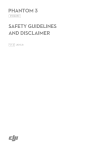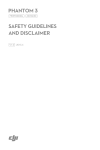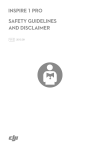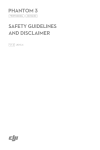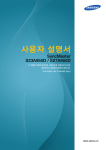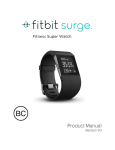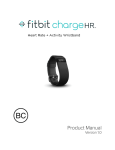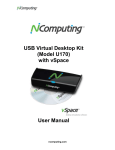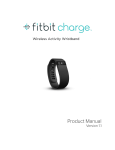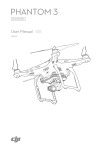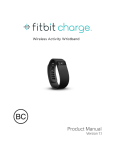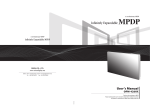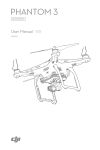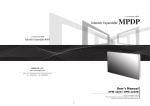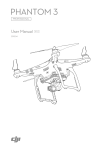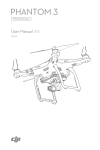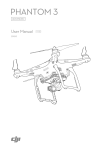Download DJI MATRICE 100 DISCLAIMER AND SAFETY GUIDELINES
Transcript
DJI MATRICE 100 DISCLAIMER AND SAFETY GUIDELINES V1.0 2015.6 NOTICE All instructions and other collateral documents are subject to change at the sole discretion of SZ DJI TECHNOLOGY CO., LTD. For up-to-date product information, visit https://dev.dji.com and click on the DJI Matrice 100 product page. Glossary The following terms are used throughout the product literature to indicate various levels of potential harm when operating this product: NOTICE: Procedures, which if not properly followed, create a possibility of physical property damage AND a little or no possibility of injury. CAUTION: Procedures, which if not properly followed, create the probability of physical property damage AND a possibility of serious injury. WARNING: Procedures, which if not properly followed, create the probability of property damage, collateral damage, and serious injury OR create a high probability of superficial injury. Read the ENTIRE user manual to become familiar with the features of this product before operating. Failure to operate the product correctly can result in damage to the product or personal property and cause serious injury. This is a sophisticated product. It must be operated with caution and common sense and requires some basic mechanical ability. Failure to operate this product in a safe and responsible manner could result in injury or damage to the product or other property. This product is not intended for use by children without direct adult supervision. Do not use with incompatible components or alter this product in any way outside of the documents provided by SZ DJI TECHNOLOGY CO., LTD. These Safety Guidelines contain instructions for safety, operation and maintenance. It is essential to read and follow all of the instructions and warnings in the user manual, prior to assembly, setup or use, in order to operate the product correctly and avoid damage or serious injury. Age Recommendation: Not for children under the age of 18. This is not a toy. Pre-flight Checklist 1) Ensure that you are using only genuine parts and that all parts are in mint condition. 2) Ensure the remote controller, Intelligent Flight Battery, and mobile device are fully charged. 3) Ensure the propellers are securely mounted onto the motors, and the motors can start and function normally. 4) Follow the on-screen instructions to calibrate the compass. 5) Ensure the DJI Pilot app and aircraft's firmware have been upgraded to the latest version. 6) Ensure that your flight area is outside the No-Fly Zones and flight conditions are suitable for flying the aircraft. 7) Be sure that you are NOT flying under the influence of alcohol, drugs or any substance that may impair your cognitive abilities. 8) Be familiar with the selected flight mode and understand all safety functions and warnings. 9) Be sure to observe all local regulations, obtain appropriate authorizations, and understand the risks. REMEMBER: It is solely your responsibility to comply with all flight regulations. © 2015 DJI. All Rights Reserved. 1 Contents NOTICE 1 Glossary 1 Pre-flight Checklist 1 Disclaimer and Warning 3 Compliance Information 4 FCC Warning Message 4 IC RSS Warning 4 KCC Warning Message 5 NCC Warning Message 5 Before You Begin 6 Individual Parts 6 Regarding Genuine and Functional Parts 6 Remote Controller 6 Flight Controller 7 Center Frame 7 Battery Compartment 7 GPS Module 7 Compass 7 Propulsion Systems 8 Camera 9 Gimbal 9 DJI Pilot App 10 Product Care 11 Storage and Transportation 11 Maintenance and Upkeep 11 Flight Condition Requirements 12 Weather Conditions and Surrounding Environment 12 Interference with Flight Controller and Communications 12 Operating the Aircraft Responsibly 12 Flight Modes, Functions and Warnings 14 Flight Modes 14 Failsafe and Return to Home 14 Low Battery 15 Compliance with Regulations & No-Fly Zones 2 9 Firmware 16 Regulations 16 No-Fly Zones 17 © 2015 DJI. All Rights Reserved. Disclaimer and Warning This product is NOT a toy and is not suitable for children under the age of 18. Adults should keep the DJI Matrice 100 out of the reach of children and exercise caution when operating this aircraft in the presence of children. This product is a flying camera that offers easy flight when in good working order as set forth below. Visit https://dev.dji.com for the most current instructions and warnings and http://knowbeforeyoufly.org/ for more information about flight safety and compliance. The information in this document affects your safety and your legal rights and responsibilities. Read this entire document carefully to ensure proper configuration before use. Failure to read and follow the instructions and warnings in this document may result in product loss, serious injury to you, or damage to your aircraft. By using this product, you hereby signify that you have read this disclaimer carefully and that you understand and agree to abide by the terms and conditions herein. You agree that you are solely responsible for your own conduct while using this product, and for any consequences thereof. You agree to use this product only for purposes that are proper and in accordance with all applicable laws, rules, and regulations, including international and domestic airspace regulations, and all terms, precautions, practices, policies and guidelines DJI has made and may make available. DJI accepts no liability for damage, injury or any legal responsibility incurred directly or indirectly from the use of this product. The user shall observe safe and lawful practices including, but not limited to, those set forth in these Safety Guidelines. Data Storage and Usage When you use our mobile app or our products or other software, data regarding the use and operation of the product, such as flight telemetry data (e.g., speed, altitude, battery life, and information about the gimbal and camera) and operations records, may be automatically or manually uploaded to and maintained on a DJI-designated server. The internal storage device incorporated into the product stores various types of data, including flight telemetry data. You may also provide flight telemetry data and other data to us when you manually transmit that information from the internal storage device to us. The information that is automatically uploaded or manually uploaded to us does not include personal data (i.e., your name, address, email, or other information that specifically identifies you), but personal data, such as your user name, may become associated with, used to identify, or tagged to such uploaded information when we store it. We separately describe how we use your user name and other personal data on our privacy policy at http://www.dji.com/policy. By using the product, the mobile app or other software we distribute, or by manually providing data to us, you consent to the following: • Our storage of any flight telemetry data and other data uploaded or provided to us, including in combination with your user name; • Our use of any such data uploaded or provided (including your user name) in connection providing support and services to you and to improve our products; • Our disclosure of such data uploaded or provided (including your user name) to our agents and/or contractors who may use it on our behalf or in connection with their relationship with us; and • Our disclosure of such uploaded or provided data (including your user name) as required by law, in a matter of public safety or policy, as needed in connection with the transfer of our business assets, or if we believe in good faith that sharing the data is necessary to protect our rights or property. © 2015 DJI. All Rights Reserved. 3 Compliance Information FCC Warning Message Any Changes or modifications not expressly approved by the party responsible for compliance could void the user’s authority to operate the equipment. This device complies with part 15 of the FCC Rules. Operation is subject to the following two conditions: (1) This device may not cause harmful interference, and (2) this device must accept any interference received, including interference that may cause undesired operation. FCC Radiation Exposure Statement: This equipment complies with FCC radiation exposure limits set forth for an uncontrolled environment. This equipment should be installed and operated with minimum distance 20cm between the radiator & your body. This transmitter must not be co-located or operating in conjunction with any other antenna or transmitter. Note: This equipment has been tested and found to comply with the limits for a Class B digital device, pursuant to part 15 of the FCC Rules. These limits are designed to provide reasonable protection against harmful interference in a residential installation. This equipment generates uses and can radiate radio frequency energy and, if not installed and used in accordance with the instructions, may cause harmful interference to radio communications. However, there is no guarantee that interference will not occur in a particular installation. If this equipment does cause harmful interference to radio or television reception, which can be determined by turning the equipment off and on, the user is encouraged to try to correct the interference by one or more of the following measures: Reorient or relocate the receiving antenna. Increase the separation between the equipment and receiver. Connect the equipment into an outlet on a circuit different from that to which the receiver is connected. Consult the dealer or an experienced radio/TV technician for help. IC RSS Warning This device complies with Industry Canada licence-exempt RSS standard (s). Operation is subject to the following two conditions: (1) this device may not cause interference, and (2) this device must accept any interference, including interference that may cause undesired operation of the device. Le présent appareil est conforme aux CNR d'Industrie Canada applicables aux appareils radio exempts de licence. L'exploitation est autorisée aux deux conditions suivantes: (1) l'appareil ne doit pas produire de brouillage, et (2) l'utilisateur de l'appareil doit accepter tout brouillage radioélectrique subi, même si le brouillage est susceptible d'en compromettre le fonctionnement. IC Radiation Exposure Statement: This equipment complies with IC RF radiation exposure limits set forth for an uncontrolled environment. This transmitter must not be co-located or operating in conjunction with any other antenna or transmitter. This equipment should be installed and operated with minimum distance 20cm between the radiator & your body. Any Changes or modifications not expressly approved by the party responsible for compliance could void the user’s authority to operate the equipment. 4 © 2015 DJI. All Rights Reserved. KCC Warning Message “해당무선설비는 운용 중 전파혼신 가능성이 있으므로 인명안전과 관련된 서비스는 할 수 없습니다 .” “해당 무선설비는 운용 중 전파혼신 가능성이 있음” 인증받은자의 상호 : SZ DJI TECHNOLOGY CO., LTD 제품명 / 모델명 : 특정소출력무선기기 ( 무선데이터통신시스템용무선기기 )/M100 제조자 및 제조국가 : SZ DJI TECHNOLOGY CO., LTD 제조년월 : 2015.05 인증번호 : MSIP-CRM-dji-TP1406 해당 무선설비는 전파혼신 가능 성이 있으므로 인명안전과 관련된 서비스는 할 수 없음 NCC Warning Message Administrative Regulations on Low Power Radio Waves Radiated Devices warning: Article 12 Without permission granted by the NCC, any company, enterprise, or user is not allowed to change frequency, enhance transmitting power or alter original characteristic as well as performance to an approved low power radio-frequency devices. Article 14 The low power radio-frequency devices shall not influence aircraft security and interfere legal communications; If found, the user shall cease operating immediately until no interference is achieved. The said legal communications means radio communications is operated in compliance with the Telecommunications Act. The low power radio-frequency devices must be susceptible with the interference from legal communications or ISM radio wave radiated devices. DJI reserves the right to update this Disclaimer and Safety Guidelines. Please visit https://dev.dji.com and check your email periodically for the latest version. This disclaimer is made in various language versions; in the event of divergence among different versions, the English version shall prevail. © 2015 DJI. All Rights Reserved. 5 Before You Begin The following documents have been produced to help you safely operate and make full use of your DJI Matrice 100: DJI Matrice 100 In the Box DJI Matrice 100 Disclaimer and Safety Guidelines DJI Matrice 100 Intelligent Flight Battery Safety Guidelines DJI Matrice 100 User Manual Check to see that you have all of the components listed in the DJI Matrice 100 In the Box document. Before assembly, read the DJI Matrice 100 Disclaimer and Safety Guidelines . Complete the assembly with the help of the DJI Matrice 100 User Manual and the video tutorial on the DJI website (https://dev.dji. com). For more information, please refer to the DJI Matrice 100 User Manual available on the DJI website. Make sure you fully understand the functionality of each individual part, the flight condition requirements, the key contingency warning functions/systems, and all government regulations before each flight. If you have any questions or problems during the assembly, maintenance or use of this product, please contact DJI or a DJI authorized dealer. Individual Parts Regarding Genuine and Functional Parts To avoid component malfunction, serious injury, and property damage, observe the following rules: 1) Use only genuine DJI parts or parts certified by DJI. Unauthorized parts or parts from non-DJI certified manufacturers may cause system malfunctions and compromise safety. 2) Ensure there are no foreign objects (such as water, oil, soil, sand, etc.) inside of the aircraft or its components. 3) Ensure the aircraft and its components – including but not limited to the remote controller, GPS module, compass, propulsion system, and battery – are all in good working order, damage-free, and functioning well. Refer to the remaining sections in this document for more details on how to ensure the functionality of these components. Remote Controller 1) Ensure the remote controller is fully charged before each flight. 2) If the remote controller is powered on and has NOT been used for 5 minutes, it will sound an alert. After 10 minutes it will automatically power off. Move the sticks or perform some other action to cancel the alert. 3) Adjust the clamp of the mobile device holder to allow a firm grip on your mobile device. 4) Ensure the mobile device holder is firmly in place and does not slip. 5) Ensure the antennas of the remote controller are unfolded and adjusted to the proper position to achieve optimal transmission quality. 6) Repair or replace the remote controller if damaged. A damaged remote controller antenna will greatly decrease performance. 7) For the GPS in the remote controller to function properly and the Dynamic Home Point to be accurate, ensure the DJI logo is facing the sky and keep the remote controller away from any metal objects. 8) Linking is required if you wish to replace your remote controller or receiver or add a new remote controller. Refer to the User Manual for details. 6 © 2015 DJI. All Rights Reserved. Flight Controller To avoid component malfunction, serious injury, and property damage, observe the following rules: 1) Do NOT attempt to modify the structure of the flight controller. 2) Ensure that the cooling fan of the flight controller is in good condition and working properly. If not, repair it immediately. 3) Keep the cooling fan clean and free of foreign articles. 4) Do NOT touch the cooling fan when it is spinning, as this may result in injury. Center Frame To avoid component malfunction, serious injury, and property damage, observe the following rules: 1) Do NOT short out the reserved ports on the center frame. 2) Connect your own devices in strict accordance with the specifications of the reserved ports. Battery Compartment To avoid component malfunction, serious injury, and property damage, observe the following rules: 1) Never use non-DJI batteries. 2) Do NOT attempt to modify the structure of the battery compartment. GPS Module To avoid component malfunction, serious injury, and property damage, observe the following rules: 1) Ensure that the collapsible mount of the GPS module is unfolded before each flight. 2) Ensure that the GPS module is securely mounted and that the arrow is pointing towards the nose of the aircraft. 1) Avoid catching your fingers in the collapsible mount of the GPS module. 2) Separate the GPS module from the body of the aircraft using the extension rod. Compass To avoid possible serious injury and property damage, observe the following rule: 1) Land immediately when severe drifting occurs in flight, i.e., the aircraft does NOT fly in straight lines. © 2015 DJI. All Rights Reserved. 7 1) Ensure the compass is calibrated before every flight. Failure to calibrate may lead to poor flight performance or a crash. 2) Do NOT attempt to calibrate your compass where there is a chance of strong magnetic interference. This includes areas where there are massive metal objects, parking structures, steel reinforcements underground, or under bridges. 3) Do NOT carry ferromagnetic materials with you during calibration, such as keys or mobile phones. 4) The compass should always be calibrated when moving from indoor spaces to outdoor spaces. 5) If the rear LEDs show a solid red light, compass calibration has failed. Please recalibrate. 6) After successful calibration, the compass may become abnormal when you place the aircraft on the ground. This may be because of underground magnetic interference. Move the aircraft to another location and try again. 7) When to recalibrate a) When compass data is abnormal, and the Aircraft Status Indicator is blinking red and yellow. b) When flying in a new location, or a location that is different from your last flight. c) When the mechanical structure of the aircraft has changed, i.e. new mounting position of the compass. d) When severe drifting occurs in flight, i.e. the aircraft does NOT fly in straight lines. Propulsion Systems To avoid serious injury to yourself or others, which may be caused by the rotating propellers and motors, observe the following rules: Propellers 1) Do NOT use aged, chipped, or broken propellers. 2) Always power off the aircraft before touching the propellers. 3) Be aware of the sharp edges of the propellers when mounting or removing the propellers. Wear gloves or take other protective measures when touching the propellers. 4) Whenever necessary, use tools (e.g., wrench, screwdriver, pliers, etc.) to remove or install the propellers. 5) Ensure the propellers are securely mounted to prevent them from falling off the motors. 6) Do NOT turn on the motors when propellers are mounted and there are other people or animals in the immediate vicinity. Motors 1) Ensure the motors are securely mounted and rotating smoothly. 2) Do NOT attempt to modify the structure of the motors. 3) Do NOT touch or let your hands or body come in contact with the motors after flight as they may be hot. To avoid possible serious injury and property damage, observe the following rule: 1) Do NOT block any of the ventilation holes on the motors. 8 © 2015 DJI. All Rights Reserved. Motors 1) Keep the motors free of dust. 2) If a motor is stuck and unable to rotate freely, execute the CSC (Combination Stick Command) to stop the motors immediately. Electronic Speed Controllers 1) Ensure the ESCs sound a normal tune when powered on. Camera To avoid possible serious injury and property damage, observe the following rule: 1) Do NOT block any ventilation holes on the camera as the heat generated may hurt you and damage the device. 1) Check camera settings before use to make sure you can adjust them to fit your needs. 2) Test the camera by shooting a few test images and check that it is operating correctly before shooting important pictures or videos. 3) Do NOT remove the micro-SD card from the camera when it is powered on. 4) Photos or videos cannot be transmitted or copied from the camera if the Intelligent Flight Battery is powered off. 5) Be sure to power off the Intelligent Flight Battery correctly, otherwise your camera parameters will NOT be saved and any recorded videos may be damaged. NOTE: Regardless of the reason, DJI will not be responsible for any failure of an image or video to be recorded or having been recorded in a way that is not machine readable. Gimbal 1) Precision elements in the gimbal may be damaged in a collision or impact, which may cause the gimbal to function abnormally. 2) Do NOT apply external force to the gimbal after the gimbal is powered on. 3) Do NOT add any payloads to the gimbal, as this may cause the gimbal to function abnormally or even lead to motor damage. 4) Hold the gimbal firmly when detaching or reattaching it, so it does not drop. DJI Pilot App 1) Be sure to fully charge your tablet or mobile device before launching the DJI Pilot app. A tablet is recommended for a better user experience. 2) If you are using a phone as your mobile display device, be sure to continue flying safely when the phone © 2015 DJI. All Rights Reserved. 9 receives an incoming call. Do NOT accept phone calls during flight. 3) Read all prompted safety tips, warning messages, and disclaimers carefully. Be familiar with the related regulations in your area. You are solely responsible for being aware of all relevant regulations and flying in a way that is compliant. a) Read and understand the warning messages before using the Auto-take off and Auto-landing features. b) Read and understand the warning messages before re-setting your Home Point. c) Read and understand the warning messages and disclaimer before setting the altitude beyond the default limit. d) Read and understand the warning messages and disclaimer before switching between flight modes. 4) Land your aircraft immediately if there is an alert shown on the app. 5) Examine and check all warning messages on the checklist displayed in the app prior to each flight. 6) Use the in-app simulator to practice your flight skills if you have never operated the aircraft or if you do not have sufficient experience to be comfortable operating the aircraft. 7) Beginner Mode is enabled by default when you launch the DJI Pilot app for the first time. The aircraft’s altitude and flight distance is restricted when flying in Beginner Mode. We recommend you fly in Beginner Mode to perfect your flight skills. Operate the actual aircraft only after you are confident that you have mastered adequate flight skills. 8) Cache the map data of the area where you intend to fly the aircraft by connecting to the Internet before each flight. Firmware To avoid serious injury to children and animals, observe the following rule: 1) Keep children and animals at a safe distance during any firmware upgrade, system calibration, and parameter setting procedures. 1) For safety, always update the firmware to the latest version when an upgrade notification is shown in the DJI Pilot app. 2) Firmware upgrade notifications will prompt you to proceed with an update immediately or to update the firmware within three days. If you choose to ignore the current firmware update, you are required to accept the prompted disclaimer. You further understand and agree that the data including but not limited to flight telemetry data and user selection records may be uploaded to and maintained on a DJIdesignated server. 3) Only use official DJI firmware. Verify the file integrity of the firmware package downloaded from the DJI Developers website (https://dev.dji.com) before upgrading. 4) Be sure to update the remote controller’s firmware to the latest version after you update the aircraft’s firmware. 5) The remote controller may become unlinked from the aircraft after updating. Re-link the remote controller and aircraft. 6) Be sure to check all connections and remove the propellers from the motors before performing the firmware update. 7) Ensure there is only one firmware package file stored on your SD card. 8) Only storage devices that are formatted for FAT32 and exFAT file systems are supported for aircraft and remote controller firmware updates. 9) Delete any automatically generated .txt files on the SD card when updating multiple remote controllers. 10 © 2015 DJI. All Rights Reserved. Product Care Storage and Transportation To avoid serious injury to children and animals, observe the following rules: 1) Small parts, such as cables and straps, are dangerous if swallowed. Keep all parts out of reach of children and animals. 2) Remove the Intelligent Flight Battery during transportation. 3) Remove the gimbal from the aircraft during transportation or when storing for an extended period. 1) Store the Intelligent Flight Battery and remote controller in a cool, dry place away from direct sunlight to ensure the built-in LiPo battery does NOT overheat. Recommended storage temperature: between 22°C and 28°C for storage periods of more than three months. Never store in environments outside the temperature range of -20°C to 45°C. 2) Do NOT allow the camera to come into contact with, or become immersed in, water or other liquids. If it gets wet, wipe dry with a soft, absorbent cloth. Turning on an aircraft that has fallen into water may cause permanent component damage. Do NOT use substances containing alcohol, benzene, thinners or other flammable substances to clean or maintain the camera. Do NOT store the camera in humid or dusty areas. 3) Do NOT connect this product to any USB interface that is older than version 2.0. Do NOT connect this product to any "power USB" or similar devices. Maintenance and Upkeep 1) Check every part of the aircraft after any crash or violent impact. If you have any problems or questions, please contact a DJI authorized dealer. 2) Regularly check the Battery Level Indicators to see the current battery level and overall battery life. When the battery life reaches 0%, it can no longer be used. © 2015 DJI. All Rights Reserved. 11 Flight Condition Requirements Weather Conditions and Surrounding Environment The aircraft is designed to operate in good to moderate weather conditions. To avoid collision, serious injury and property damage, observe the following rules: 1) Do NOT use the aircraft in severe weather conditions. These include wind speeds exceeding 10 m/s, snow, rain, smog, heavy wind, hail, lightning, tornadoes or hurricanes. 2) Keep the aircraft at least 10 meters (30 feet) away from obstacles, people, animals, buildings, public infrastructure, trees, and bodies of water when in flight. Stay even further away from the above objects as your altitude increases. 3) Be EXTRA cautious when operating the aircraft indoors. 1) Aircraft and battery performance is subject to environmental factors such as air density and temperature. a) Be very careful when flying 14,700 feet (4,500 meters) or more above sea level as battery and aircraft performance may be reduced. 2) Do NOT use the aircraft near accidents, fire, explosions, floods, tsunamis, avalanches, landslides, earthquakes, dust, or sandstorms. Interference with Flight Controller and Communications 1) Fly in open areas. Tall buildings or steel structures may affect the accuracy of the on-board compass and block the GPS signal. 2) Avoid interference between the remote controller and other wireless equipment. Make sure to turn off the Wi-Fi on your mobile device. 3) Do NOT fly near areas with magnetic or radio interference. These include but are NOT limited to: high voltage lines, large scale power transmission stations or mobile base stations and broadcasting towers. Failing to do so may compromise the transmission quality of this product or cause remote controller and video transmission errors which may affect flight orientation and location accuracy. The aircraft may behave abnormally or go out of control in areas with too much interference. Operating the Aircraft Responsibly To avoid serious injury and property damage, observe the following rules: 1) Make sure you are NOT drunk, taking drugs, under the influence of anesthesia, or suffering from dizziness, fatigue, nausea or any other conditions, whether physical or mental, that could impair your ability to operate the aircraft safely. 2) Do NOT perform the Combination Stick Commands when aircraft is in midair, otherwise the motors will stop. 3) Upon landing, power off the aircraft first, then switch off the remote controller. 12 © 2015 DJI. All Rights Reserved. 4) Do NOT drop, launch, fire or otherwise project any dangerous payloads on or at any buildings, persons or animals, or which could cause personal injury or property damage. 1) Make sure you have been sufficiently trained and are fully aware of any contingency plans before accidents happen. 2) Make sure you have a flight plan and never fly the aircraft recklessly. 3) Respect the privacy of others when using the camera. Make sure you comply with local privacy laws, regulations, and moral standards. 4) Do NOT use this product for any reason other than general personal use. Do NOT use it for any illegal or inappropriate purpose (such as spying, military operations, or unauthorized investigations). 5) Do NOT use this product to defame, abuse, harass, stalk, threaten or otherwise violate the legal rights (such as the right of privacy and publicity) of others. 6) Do NOT trespass into private property of others. © 2015 DJI. All Rights Reserved. 13 Flight Modes, Functions and Warnings Flight Modes To avoid serious injury and property damage, observe the following rule: 1) Do NOT switch from P mode to either A mode or F mode unless you are sufficiently familiar with the aircraft’s behavior for each flight mode, since disabling GPS may result in being unable to land the aircraft safely. P mode is preferred for most flying scenarios. Users can switch to A mode where and when P mode is unavailable. Be aware that some features are NOT available for A mode, and therefore be EXTRA cautious when flying in A mode. 1) P mode (Positioning): P mode works best when the GPS signal is strong. There are two different states of P mode, which will be automatically selected by the DJI Matrice 100 depending on GPS signal strength: a) P-GPS: GPS is available, and the aircraft is using GPS for positioning. b) P-ATTI: When GPS is not available, the aircraft is using only its barometer for positioning, so only altitude is controlled. 2) A mode (Attitude): The GPS is NOT used for positioning. The aircraft only uses its barometer to maintain altitude. If it is still receiving a GPS signal, the aircraft can automatically return home if the Remote Controller signal is lost and if the Home Point has been recorded successfully. 3) F mode (Function): Intelligent Orientation Control (IOC) is activated in this mode. Ensure you are familiar with IOC functions before use. If you intend to switch to modes that disable GPS assistance (e.g., A mode), you are required to accept the prompted disclaimer to enable this function. If this function is enabled, you further understand and agree that data including but not limited to flight telemetry data and function records could be uploaded to and maintained on a DJI designated server. Failsafe and Return to Home 1) The Return to Home feature will NOT work if the GPS signal is insufficient or if GPS is not active. 2) Press the RTH (Return to Home) Button on the remote controller to bring the aircraft back to the Home Point instead of turning off the remote controller. 3) Tall buildings may adversely affect the Failsafe function. Please adjust the aircraft location, altitude and speed while returning home to avoid obstacles. 4) Make sure to always fly the aircraft within the transmission range of the remote controller. 5) When updating the Home Point, do NOT block the GPS signal of the remote controller and ensure the new Home Point is correct on the live map. 6) Only use the Failsafe and Return to Home functions in case of emergency, as they may be affected by the weather, the environment, or any nearby magnetic fields. 7) Do NOT update the Home Point near tall buildings, as the GPS may be blocked and lead to an incorrect location being stored. 8) The aircraft cannot avoid obstacles during the Failsafe RTH; therefore it is important to set an appropriate 14 © 2015 DJI. All Rights Reserved. Failsafe altitude before each flight. 9) Dynamic home point is useful in situations when you are in motion and require a Home Point that is different from the takeoff point. Low Battery 1) When the Critical Battery Level Warning activates and the aircraft is descending automatically, you may push the throttle up to maintain the aircraft's altitude and navigate it to a more appropriate location for landing. 2) When battery warnings are triggered, promptly bring the aircraft back to the Home Point or land to avoid losing power during flight and causing damage to the aircraft, property, animals, and people. © 2015 DJI. All Rights Reserved. 15 Compliance with Regulations & No-Fly Zones Regulations To avoid non-compliant behavior, serious injury and property damage, observe the following rules: 1) Do NOT operate in the vicinity of manned aircraft, regardless of altitude. (Land immediately if necessary) 2) Do NOT fly the aircraft in densely populated areas, including cities, sporting events, exhibitions, performances, etc. 3) Do NOT fly the aircraft above the authorized altitude. Remain well clear of and do NOT interfere with manned aircraft operations. Be aware of and avoid other aircraft and obstacles at all times. To avoid non-compliant behavior, serious injury and property damage, observe the following rules: 1) Do NOT fly the aircraft near or inside no-fly zones specified by local laws and regulations. The no-fly zone list includes: airports, borders between two sovereign countries or regions, major cities/regions, etc., and is continuously updated. 2) Do NOT fly the aircraft above the authorized altitude 3) ALWAYS keep your aircraft within visual line of sight (VLOS), and use an observer to assist if needed. 4) NEVER use the aircraft to carry illegal or dangerous goods/payloads. 1) Make sure you understand the nature/type of your flight operation (such as for recreation, for public use, or for commercial use) and have obtained corresponding approval and clearance from the related government agencies before flight. Consult with your local regulators for comprehensive definitions and specific requirements. For users operating their aircraft in the United States, please first visit http://www. knowbeforeyoufly.org/ and take action appropriate to your circumstances. 2) Please note that remote controlled aircraft may be banned from conducting commercial activities in certain countries and regions. Check and follow all local laws and ordinances before flying as those rules may differ from those stated here. 3) Do NOT fly around sensitive infrastructure or property such as power stations, water treatment facilities, correctional facilities, heavily traveled roadways, government facilities, military zones, etc. 4) Respect the privacy of others when using the camera. Do NOT conduct surveillance operations such as image capture or video recording on any person, entity, event, performance, exhibition, and property without authorization or where there is an expectation of privacy, even if the image or video is captured for personal use. 5) Please be advised that in certain areas, the recording of images and videos from events, performances, exhibitions, or commercial properties by means of a camera may contravene copyright or other legal rights, even if the image or video was shot for personal use. 16 © 2015 DJI. All Rights Reserved. No-Fly Zones DJI always stresses safety during flight, and has therefore developed various aids to help users comply with local rules and regulations while flying. We strongly recommend that you update the firmware to the latest version to ensure the following features are fully updated: No-Fly Zones 1) No-Fly Zones include but are not limited to major airports around world, borders between two sovereign countries or regions, major cities/regions, etc. 2) The complete list of No-Fly Zones is listed on the official DJI website at http://flysafe.dji.com/no-fly and is subject to periodic updates in line with the latest regulatory requirements without prior notice. 3) Some No-Fly Zones are comprised of several zones. Each zone features circles of various sizes. The aircraft will NOT be able to take off in the inner most zone of the No-Fly Zone, and will descend to the specified altitude when it approaches the edge of the inner most zone. Ground station functionality is disabled when the aircraft is within a No-Fly Zone. 4) Users are NOT able to set up waypoints within No-Fly Zones. Altitude Limit 1) Fly NO higher than 120 meters (400 feet) above ground level and stay away from any surrounding obstacles. If you intend to fly above the default altitude limit, you are required to accept the prompted disclaimer to enable the new altitude limit. If a new altitude limit is set, you further understand and agree that data including but not limited to flight telemetry data and altitude limit changes could be uploaded to and maintained on a DJI-designated server. © 2015 DJI. All Rights Reserved. 17 This content is subject to change. Download the latest version from https://dev.dji.com/products/flying-platforms/matrice-100 If you have any questions about this document, please contact DJI by sending a message to [email protected]. © 2015 DJI. All Rights Reserved.



















